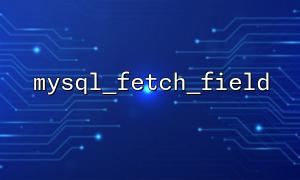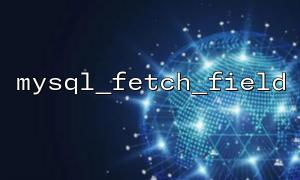Getting field information is a common requirement when operating a MySQL database in PHP. Traditionally, the mysql_fetch_field function is used to obtain the metadata information of fields in the query results; and with the development of PHP, PDO (PHP Data Objects) has become a more modern and flexible database operation interface. This article will conduct in-depth comparison and analysis on the differences between the two in obtaining field information to help developers make reasonable choices in actual projects.
mysql_fetch_field
This is part of the early MySQL extension, specifically used to extract fields one by one from the mysql_query result set, such as field name, type, length, etc. This extension is abandoned in PHP7 and is not recommended for new projects.
PDO
PDO is an object-oriented database access abstraction layer that supports multiple database drivers. It provides a unified interface and rich functions, among which the methods of obtaining field information are relatively diverse, usually implemented through the getColumnMeta() method of the PDOStatement object.
<?php
$link = mysql_connect('gitbox.net', 'username', 'password');
mysql_select_db('testdb', $link);
$result = mysql_query('SELECT id, name FROM users', $link);
$field_count = mysql_num_fields($result);
for ($i = 0; $i < $field_count; $i++) {
$field_info = mysql_fetch_field($result, $i);
echo "Field name: " . $field_info->name . "\n";
echo "type: " . $field_info->type . "\n";
echo "length: " . $field_info->length . "\n\n";
}
mysql_close($link);
?>
<?php
$pdo = new PDO('mysql:host=gitbox.net;dbname=testdb', 'username', 'password');
$stmt = $pdo->query('SELECT id, name FROM users');
for ($i = 0; $i < $stmt->columnCount(); $i++) {
$meta = $stmt->getColumnMeta($i);
echo "Field name: " . $meta['name'] . "\n";
echo "数据type: " . $meta['native_type'] . "\n";
echo "length: " . $meta['len'] . "\n\n";
}
?>
| characteristic | mysql_fetch_field | PDO getColumnMeta |
|---|---|---|
| Extended Status | Old extension, PHP7 is deprecated | Modern expansion, long-term support |
| How to use | Functional, based on resource handles | Object-oriented, based on PDOStatement objects |
| Support database types | Only support MySQL | Supports multiple databases |
| Return to information richness | Only basic field information (name, type, length) is provided | Provide more detailed metadata (including table names, database names, etc.) |
| Safety and stability | Discarded, poor safety and performance | Supports preprocessing, safe and excellent performance |
| Error handling | Judging by the function return value | Easy to catch by exception mechanism |
| flexibility | Extensions limited by MySQL | Flexible support for multiple databases, easy to scale |
PDO is preferred for new projects
PDO not only supports safer parameter binding to avoid the risk of SQL injection , but also provides richer and more standardized field information, which is convenient for cross-database migration and maintenance.
Trade-offs when maintaining old projects <br> If the project is still using old MySQL extensions and cannot be migrated immediately, you can temporarily continue to use mysql_fetch_field , but you should plan the upgrade path and switch to PDO or MySQLi as early as possible.
Pay attention to the compatibility of getColumnMeta <br> Although PDO provides the getColumnMeta() method, some database drivers do not fully support this method and need to be tested and confirmed during development.
| point | mysql_fetch_field | PDO getColumnMeta |
|---|---|---|
| applicability | Old project, abandoned | New project, recommended |
| Function | Basic field information | Rich and standardized field metadata |
| Safety | Lower | High, supports preprocessing statements and exception handling |
| flexibility | MySQL only | Multi-database support, strong scalability |
Overall, mysql_fetch_field is only suitable for maintenance of historical projects, and modern development should use PDO. Through PDO, developers not only obtain a more secure database interaction experience, but also more conveniently obtain and utilize the metadata information of fields, thereby improving the robustness and maintainability of the code.
Related Tags:
PDO



